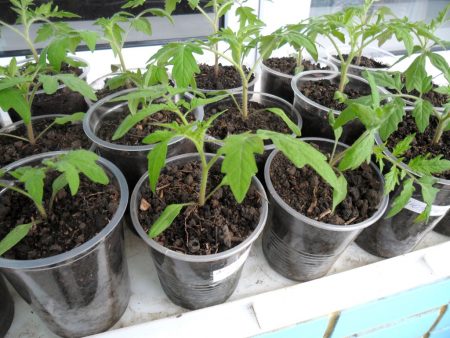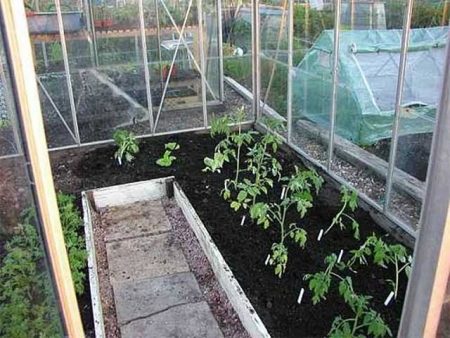 Many tomato varieties are named after their characteristic features, as well as the direct purpose of the fruit. One of these varieties is Forshmak tomato, bred by originators specifically for stuffing.
Many tomato varieties are named after their characteristic features, as well as the direct purpose of the fruit. One of these varieties is Forshmak tomato, bred by originators specifically for stuffing.
All similar types have very thick walls that retain their shape perfectly even after heat treatment. Stuffed tomatoes do not have a special purpose for using them fresh or in canning. They are mainly used for frying and baking.
Content
Forshmak tomato variety typography
Tomato Forshmak is a medium early ripening variety. The return of technically ripe tomatoes begins on 108-118 days after the appearance of the first seedlings sprouts. A plant is an indeterminant that has an unfinished growth tendency. However, when growing it in open ground, the tomato reaches a height of 1.8-2.2 meters. Designed for cultivation in film and arched shelters in the middle and northern regions. In the southern and central regions of Russia, Ukraine and Moldova, it is successfully grown in open ground.
Tomato bush Forshmak medium-leaved. The fruits are not very large, reaching weight parameters of 60-85 g of a hexagonal shape, with a pronounced ribbing. In the stage of technical maturity, Forshmak fruits have a bright red color with yellow-orange strokes. In the context, the fetus has 3-4 hollow chambers with seeds and fleshy flesh.
The yield of Forshmak productivity under the condition of cultivation in open ground is 6-8 kg, and, when cultivating tomato in film or arched shelters - 9-1 kg. Needs a garter to stakes or trellises. It has remarkable transportability.
Features of cultivation of tomato Forshmak
Forshmak is a sortotype giving all the parental characteristics to the next generation. Therefore, tomato seeds can be collected on their own, without losing the variety from their sites for many years. Selected and dried seeds must undergo disinfection, which consists in immersing them in a weak solution of potassium permanganate (0.01 g per 1 liter of water) for half an hour, followed by soaking in any growth stimulator according to the instructions.
Sowing prepared seeds is carried out in the second or third decade of March. Tanks with soil are brought into a warm room, the soil is moistened, and the seeds are laid out on the soil with a distance of 1.5 cm by 1.5 cm from each other. Then the grains are pressed into the soil to a depth of about 1 cm and sprinkled with soil mixture. After a few days, loops of emerging seedlings begin to appear above the surface of the soil. After they appear, the air temperature in the room is reduced by several degrees, and containers with seedlings are put in the most illuminated place.
If there are 2-3 pairs of true leaves on young plants, seedlings are dived into separate containers, while trying to deepen the base of the stem as much as possible. However, while trying not to fill the soil with the root neck of the plant.
When positive night temperatures are established in the second or third decade of May, seedlings are planted in open ground, after hardening it for 7-10 days. When growing tomatoes in the conditions of film or arched shelters, agricultural techniques associated with planting seedlings are carried out 10-16 days earlier.
The whole season of cultivation of Forshmak, it is necessary to carry out all the relevant agricultural practices:
- watering with warm, settled water under the root once every three days;
- mandatory loosening of the soil after irrigation;
- tying to trellises or stakes;
- pinching and tomato formation in 1-2 stems;
- top dressing 3 times per season: after survival of seedlings, at the time of ejection of flower brushes, at the time of pouring fruit.
Diseases and Pests
Tomato Forshmak is distinguished by a worthy immunity from diseases. Pathogens bypass it, however, when establishing prolonged rainy and cold weather, tomatoes can be attacked by rot. For the purpose of prevention, bushes are treated with copper-containing preparations 1-2 times per season.
Of the pests, the greatest danger to the tomato is the garden scoop and whitefly. To neutralize the pests, treatment is carried out with Confidor Maxi and Actara, which are bred according to the instructions.
The use of tomato Forshmak and reviews about it
According to the reviews of gardeners growing Forshmak in their areas, the tomato proved to be very worthy, showing excellent yield and resistance to disease.
Tomato is completely unsuitable for preservation in home-made preparations in its entirety, however, juice and pasta come out of it quite well. Forshmak finds particular use in stuffing and baking it. And, having low acid, its fruits are suitable for people suffering from gastritis.




 Low-growing tomatoes, without pinching: 5 of the most delicious varieties
Low-growing tomatoes, without pinching: 5 of the most delicious varieties Why tomato seedlings grow poorly
Why tomato seedlings grow poorly We grow a tomato in a shell
We grow a tomato in a shell Growing tomatoes without watering according to the method of Kazarin
Growing tomatoes without watering according to the method of Kazarin